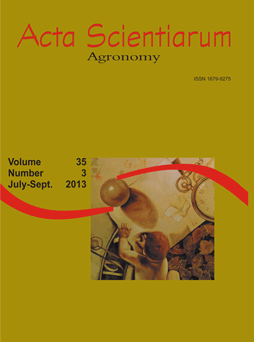<b>The use of multiple endmember spectral mixture analysis (MESMA) for the mapping of soil attributes using Aster imagery</b> - doi: 10.4025/actasciagron.v35i3.16119
Abstract
Systematic, physically based acquisition of information regarding soils is required to meet increasing demand in agricultural and environmental systems. The objective of this work is to evaluate the use of multiple endmember spectral mixture analysis (MESMA) for mapping soil attributes within ASTER imagery. A total of 184 georeferenced soil samples were collected from Rafard, São Paulo State, Brazil. These points were overlain on the satellite image to collect spectral data. The laboratory and image information were then arranged and prepared by clustering samples into classes based on the following soil attributes: texture, organic matter, base saturation (V%), CEC and total iron. Following this classification, mean spectral curves were generated for each attribute class. Spectral curves were used as endmembers for the generation of maps using MESMA. Maps of the same attributes were also generated using geostatistical analyses. Based on the two generated maps, a cross-tabulation was used to evaluate the accuracy of MESMA for mapping soil attributes. Agreement was high for maps of the texture, organic matter, CEC and total iron. We conclude that the methodology used in this work was efficient for mapping soil attributes.
Downloads
DECLARATION OF ORIGINALITY AND COPYRIGHTS
I Declare that current article is original and has not been submitted for publication, in part or in whole, to any other national or international journal.
The copyrights belong exclusively to the authors. Published content is licensed under Creative Commons Attribution 4.0 (CC BY 4.0) guidelines, which allows sharing (copy and distribution of the material in any medium or format) and adaptation (remix, transform, and build upon the material) for any purpose, even commercially, under the terms of attribution.




















































